Inspired by the visual storytelling project, Humans of New York, Maker Ed’s Communications Manager, Briana Flin, interviewed and photographed some of the presenters at our Maker Ed Stage at Maker Faire Bay Area 2015. To see the questions asked of and the answers given by each presenter/maker educator, hover over their photograph.
-
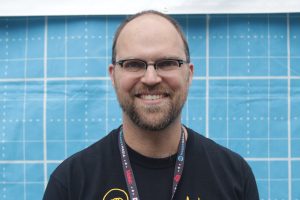 Aaron VanderwerffWhat advice would you give other adults to help facilitate creativity?“Stick to questions as much as possible. Often we want to, as adults, jump in and explain things and tell people things. But I think it’s really great just to listen, and keep that voice in your head, and just keep asking questions, and let kids come up with things. And for kids who are not really wanting to talk about it, have them draw and write and think that way, and you can keep nudging them. But I’ve found it really great, as a teacher, to ask a question and walk away. And let the kid think for a while. And then come back and find out what they’ve been thinking.”
Aaron VanderwerffWhat advice would you give other adults to help facilitate creativity?“Stick to questions as much as possible. Often we want to, as adults, jump in and explain things and tell people things. But I think it’s really great just to listen, and keep that voice in your head, and just keep asking questions, and let kids come up with things. And for kids who are not really wanting to talk about it, have them draw and write and think that way, and you can keep nudging them. But I’ve found it really great, as a teacher, to ask a question and walk away. And let the kid think for a while. And then come back and find out what they’ve been thinking.” -
 Stephanie ChangWhat have you learned from the kids you’ve worked with?“I love that they always have a fresh perspective on materials. They always experience things in a totally different way, and a rubber band can be used in so many new ways than I would have ever imagined, so I always remember to look at things with hopefully a child’s eyes.”
Stephanie ChangWhat have you learned from the kids you’ve worked with?“I love that they always have a fresh perspective on materials. They always experience things in a totally different way, and a rubber band can be used in so many new ways than I would have ever imagined, so I always remember to look at things with hopefully a child’s eyes.” -
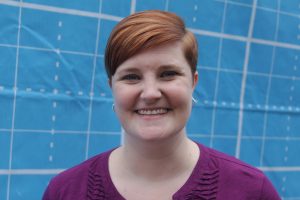 Steph GrimesWhat have you learned about yourself as a result of working with youth and making?“One of the biggest things I’ve learned is to get out of the way and trust more…I think that’s been really valuable for me to say now to the kids that I work with ‘yeah, you want to do that? Let’s make it happen.’ And I might have some sort of anxiety about how that’s going to turn out or some hesitation about what it’s going to look like at the end, but I now trust them to make good decisions about where that path takes them — even if it takes them to a failed project or something that doesn’t really work out. And just being comfortable with trusting them to make decisions that are good for them at that moment in time has been really really valuable. I’ve been able to apply that to other areas of my life, of like ‘okay I don’t necessarily know the intended outcome of this project or this curriculum that I’m supposed to write or this part of my job,’ and being able to go with the flow a little bit more has been really valuable.”
Steph GrimesWhat have you learned about yourself as a result of working with youth and making?“One of the biggest things I’ve learned is to get out of the way and trust more…I think that’s been really valuable for me to say now to the kids that I work with ‘yeah, you want to do that? Let’s make it happen.’ And I might have some sort of anxiety about how that’s going to turn out or some hesitation about what it’s going to look like at the end, but I now trust them to make good decisions about where that path takes them — even if it takes them to a failed project or something that doesn’t really work out. And just being comfortable with trusting them to make decisions that are good for them at that moment in time has been really really valuable. I’ve been able to apply that to other areas of my life, of like ‘okay I don’t necessarily know the intended outcome of this project or this curriculum that I’m supposed to write or this part of my job,’ and being able to go with the flow a little bit more has been really valuable.” -
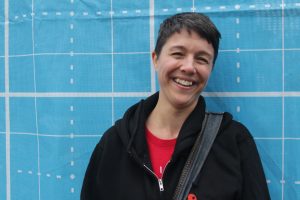 Michelle CarlsonCan you share a time when you were inspired by the kids you’ve worked with?“A time when I was inspired by kids we were working with would be: we had a group of alt ed kids in, so they were continuation high school kids, and we were giving them the tour and we were talking about the makerspace and how it can really help you find your passion, and you can explore all kinds of different things, and just find yourself in the makerspace. And this one quiet girl from the back raised her hand and said ‘You mean we can actually be ourselves here?’ And I said, “Of course, you can be yourselves here. We will love you for being yourself here.” It just made my heart swell up with joy that that was what she was getting out of the makerspace.”
Michelle CarlsonCan you share a time when you were inspired by the kids you’ve worked with?“A time when I was inspired by kids we were working with would be: we had a group of alt ed kids in, so they were continuation high school kids, and we were giving them the tour and we were talking about the makerspace and how it can really help you find your passion, and you can explore all kinds of different things, and just find yourself in the makerspace. And this one quiet girl from the back raised her hand and said ‘You mean we can actually be ourselves here?’ And I said, “Of course, you can be yourselves here. We will love you for being yourself here.” It just made my heart swell up with joy that that was what she was getting out of the makerspace.” -
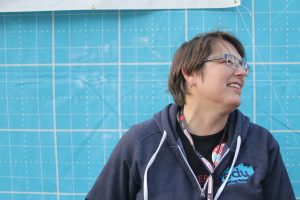 Jessica ParkerWhat advice would you give to others who are interested in bringing making to their learning environments?“The advice I would give to educators that are interested in infusing making throughout their learning environments — whether that’s K-12 or library or after school settings — would be just to start small. Don’t feel pressured to all of a sudden create a huge maker cart or a huge makerspace, but just start with something that you think would resonate with your learners — whether they are adults, whether they’re kindergartners or 1st grade students, all the way up to even 90 year olds! What would be exciting to them? And that way the stakes are lowered, everyone can get excited and the goal is really to make, right? To engage in making and then to be able to step back and reflect on that, and discuss what do we think we learned, what do we walk away with? And I think you’ll find that not only is it a matter of “I’m so excited to use my hands,” but it’s also ‘wow, I didn’t realize that when I tried to use dry spaghetti and create a marshmallow tower it was going to be this difficult!’ And then also social aspects around ‘wow, we came together as a team’ or ‘you know what, I hate my teammates, I never want to talk to them again!’ But because you’ve created an environment in which the stakes are low and in which people can come together and do a challenge that might be different or unique, it allows them to dive in and be engaged, and then reflect on that learning. So I’d say start small, allow folks to have fun, and then take a step back and reflect.”
Jessica ParkerWhat advice would you give to others who are interested in bringing making to their learning environments?“The advice I would give to educators that are interested in infusing making throughout their learning environments — whether that’s K-12 or library or after school settings — would be just to start small. Don’t feel pressured to all of a sudden create a huge maker cart or a huge makerspace, but just start with something that you think would resonate with your learners — whether they are adults, whether they’re kindergartners or 1st grade students, all the way up to even 90 year olds! What would be exciting to them? And that way the stakes are lowered, everyone can get excited and the goal is really to make, right? To engage in making and then to be able to step back and reflect on that, and discuss what do we think we learned, what do we walk away with? And I think you’ll find that not only is it a matter of “I’m so excited to use my hands,” but it’s also ‘wow, I didn’t realize that when I tried to use dry spaghetti and create a marshmallow tower it was going to be this difficult!’ And then also social aspects around ‘wow, we came together as a team’ or ‘you know what, I hate my teammates, I never want to talk to them again!’ But because you’ve created an environment in which the stakes are low and in which people can come together and do a challenge that might be different or unique, it allows them to dive in and be engaged, and then reflect on that learning. So I’d say start small, allow folks to have fun, and then take a step back and reflect.” -
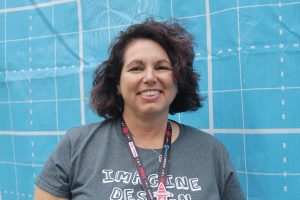 Donna SangwinWhat have you learned about yourself as a result of working with youth & making?“What I’ve learned from kids and creativity and making is that we have to be careful not to squash it. Because the younger the kids, the more willing and less afraid they are to be creative, and as they get older they seem to be more reserved. And I think that we need to be really careful to encourage the creativity and not squish it.”
Donna SangwinWhat have you learned about yourself as a result of working with youth & making?“What I’ve learned from kids and creativity and making is that we have to be careful not to squash it. Because the younger the kids, the more willing and less afraid they are to be creative, and as they get older they seem to be more reserved. And I think that we need to be really careful to encourage the creativity and not squish it.” -
 Sharon MarzoukWhat have you learned about yourself as a result of working with youth & making?“So what I’ve learned about myself from teaching youth is I don’t know everything! That it’s kind of fun to not know everything, and ask the leading questions to get them to think, and then I get to actually learn more from what they do and create.”
Sharon MarzoukWhat have you learned about yourself as a result of working with youth & making?“So what I’ve learned about myself from teaching youth is I don’t know everything! That it’s kind of fun to not know everything, and ask the leading questions to get them to think, and then I get to actually learn more from what they do and create.” -
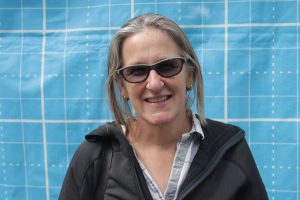 Ilya PrattWhat advice would you give other adults to help facilitate creativity?“The bottom line for creativity is stop trying to imagine what the outcome should be for the kids and then let them determine what the outcome is.”
Ilya PrattWhat advice would you give other adults to help facilitate creativity?“The bottom line for creativity is stop trying to imagine what the outcome should be for the kids and then let them determine what the outcome is.” -
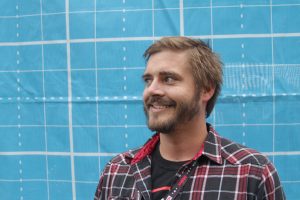 Kyle LinnikWhat led you to being a maker educator?“I’ve always been interested in knowing how things work ever since I was a little kid. So often, growing up, I was told that ‘you’re too young to learn that,’ ‘you can’t do that yet,’ ‘you’ve got to wait until you’re older.’ And that drove me nuts growing up. And now that I have my own classroom and a school that supports teacher autonomy, that’s the exactly the experience I want to give to my students, being told ‘Yes, that’s not impossible. If you can think it up, that’s something you can do, you can make it happen.’ And just giving them the freedom and the tools and the knowledge to make that happen has to be the most rewarding aspect of my job.”
Kyle LinnikWhat led you to being a maker educator?“I’ve always been interested in knowing how things work ever since I was a little kid. So often, growing up, I was told that ‘you’re too young to learn that,’ ‘you can’t do that yet,’ ‘you’ve got to wait until you’re older.’ And that drove me nuts growing up. And now that I have my own classroom and a school that supports teacher autonomy, that’s the exactly the experience I want to give to my students, being told ‘Yes, that’s not impossible. If you can think it up, that’s something you can do, you can make it happen.’ And just giving them the freedom and the tools and the knowledge to make that happen has to be the most rewarding aspect of my job.” -
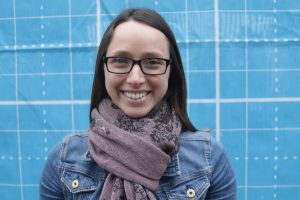 Ann McAfeeCan you share a time when you were inspired by the kids you’ve worked with?“One of the most inspiring moments during a project that we were working on with my students was when we were working on this project and we had students making delivery devices, which would convey information through movement. And they were working on designs on Adobe Illustrator to print later on the laser cutter. And my students are just as new at Adobe Illustrator as I am. And I was just really impressed by my students’ ability to persevere and their resilience. Some things that I thought were challenging and I didn’t know how to work through, I’d watch them teaching each other how to work through. Just the amount of problem solving that was involved in the project was really fun, and I think it gave students a pride and confidence that you don’t find, if you’re not making. And I think it was a pretty awesome moment.”
Ann McAfeeCan you share a time when you were inspired by the kids you’ve worked with?“One of the most inspiring moments during a project that we were working on with my students was when we were working on this project and we had students making delivery devices, which would convey information through movement. And they were working on designs on Adobe Illustrator to print later on the laser cutter. And my students are just as new at Adobe Illustrator as I am. And I was just really impressed by my students’ ability to persevere and their resilience. Some things that I thought were challenging and I didn’t know how to work through, I’d watch them teaching each other how to work through. Just the amount of problem solving that was involved in the project was really fun, and I think it gave students a pride and confidence that you don’t find, if you’re not making. And I think it was a pretty awesome moment.” -
 Liza KloskiWhat are some of your earliest and fondest memories of making anything?“One of my earliest, greatest memories of making — and I didn’t realize I was a maker until later in life — was that…I would get all of these ribbons, and glue and I would just basically make a three-dimensional scrapbook. I was just compelled to do it. I just loved it, I enjoyed the process, I enjoyed the end product. Making is I think inherent in a lot of people, if not most people, given the right tools.”
Liza KloskiWhat are some of your earliest and fondest memories of making anything?“One of my earliest, greatest memories of making — and I didn’t realize I was a maker until later in life — was that…I would get all of these ribbons, and glue and I would just basically make a three-dimensional scrapbook. I was just compelled to do it. I just loved it, I enjoyed the process, I enjoyed the end product. Making is I think inherent in a lot of people, if not most people, given the right tools.”
